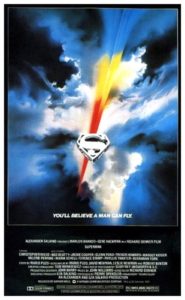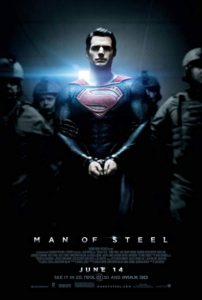 The first Superman comic was published in 1938, kick-starting the superhero genre and introducing the world to a new hero who would eventually come to fight for “truth, justice, and the American way”. There have been many iterations of the character since then across multiple mediums, including comics, television, and film, with two live-action film franchises ranking among the most popular.
The first Superman comic was published in 1938, kick-starting the superhero genre and introducing the world to a new hero who would eventually come to fight for “truth, justice, and the American way”. There have been many iterations of the character since then across multiple mediums, including comics, television, and film, with two live-action film franchises ranking among the most popular.
In 1978, Christopher Reeve donned the cape and tights and glasses to become the quintessential American superhero in Superman and, for three and a half decades, his portrayal remained definitive, as was John Williams’ equally iconic main theme for the character. However, in 2012, Henry Cavill dressed in the decidedly darker blue suit to bring us a new interpretation of Clark Kent and his heroic alter ego in Man of Steel and along came composer Hans Zimmer to dress Superman in a darker theme song as well.
Fans can argue over whether Reeve or Cavill is the better version of the character, but what can’t be argued is which of the musical themes the average person on the street would be able to sing on command. Williams’ main theme for the character is big, bold, and memorable, while Zimmer’s is decidedly more conceptual and more difficult to recreate. They are two entirely different entities that exist in two entirely different worlds, but both themes and accompanying scores actually have more in common than would seem upon first listen.
The American Way
 Williams’ theme for the 1978 film is built on a concept of music theory called “perfect intervals”. Simply put, it’s pleasant to listen to. These same intervals are prominently featured in well-known tunes such as Wagner’s “Here Comes the Bride” to the folk tune, “I’ve Been Working on the Railroad.” Many compositions feature these intervals which are memorable by virtue of being easy to sing. It should come as no surprise to learn that Williams’ score for Star Wars also largely features perfect intervals. In fact, if you’ve heard instrumental music that you’d describe as “sounding American”, the odds are high that it was based around perfect intervals. A popular example would be the American composer Aaron Copland’s “Fanfare for the Common Man”. Copland’s music has served as inspiration for “American-sounding music” for decades and Williams’ theme was partially based on “Fanfare for the Common Man”, as was his later music for Saving Private Ryan.
Williams’ theme for the 1978 film is built on a concept of music theory called “perfect intervals”. Simply put, it’s pleasant to listen to. These same intervals are prominently featured in well-known tunes such as Wagner’s “Here Comes the Bride” to the folk tune, “I’ve Been Working on the Railroad.” Many compositions feature these intervals which are memorable by virtue of being easy to sing. It should come as no surprise to learn that Williams’ score for Star Wars also largely features perfect intervals. In fact, if you’ve heard instrumental music that you’d describe as “sounding American”, the odds are high that it was based around perfect intervals. A popular example would be the American composer Aaron Copland’s “Fanfare for the Common Man”. Copland’s music has served as inspiration for “American-sounding music” for decades and Williams’ theme was partially based on “Fanfare for the Common Man”, as was his later music for Saving Private Ryan.
Williams isn’t alone, however, in composing Superman music that is entrenched in this deep sense of Americana. While Zimmer’s Superman theme isn’t as clear-cut and flat-out heroic as Williams’, the main theme for Superman in Man of Steel still features these same perfect intervals. What makes it unique in this iteration, though, is the introduction of dissonance—sounds that don’t sound as “perfect” but instead “disagree”, a “crunchiness.” If you listen to the track “This is Clark Kent” from the score release, you can hear the main theme played through a couple of times and both times we hear this dissonance making the music sound unresolved, like there’s something a little off here. This dissonance communicates a sense of being unfinished or incomplete—Clark Kent from Smallville is not yet fully Superman, American superhero. But by the end of the film, as showcased in the deluxe edition track, “What are You Going to Do When You’re Not Saving the World?”, we hear a version of the theme that is complete and free of this “crunchiness” and is fully resolved marking the transition of identities from Clark Kent to Superman. It’s a theme that shows growth; if Williams’ theme for Superman is “here I am!”, Zimmer’s theme is “here I come!”
Lights, Camera, Action
 Though they share similar elements in their main themes, both of these composers utilize their own unique approaches for the action music. Zimmer’s approach involves lots and lots and lots of heavy percussion; throughout the score, there are many “grooves” that feature repetitive percussion motifs. In “Terraforming,” not only is there a percussion groove through most of it, there is also some repetitive woodwind and brass work, as well as some dark snippets of the main theme for Superman.
Though they share similar elements in their main themes, both of these composers utilize their own unique approaches for the action music. Zimmer’s approach involves lots and lots and lots of heavy percussion; throughout the score, there are many “grooves” that feature repetitive percussion motifs. In “Terraforming,” not only is there a percussion groove through most of it, there is also some repetitive woodwind and brass work, as well as some dark snippets of the main theme for Superman.
Williams’ action music is very much in the vein of his action music for other films he has scored: quite focused on frenetic wind parts playing almost virtuosically as we go back and forth between brass and woodwinds and strings. Low brass and strings playing ostinato (a short, repetitive melodic line), non-stop motion in the higher strings and upper woodwinds, big swells from the trumpets and horns, all occasionally interrupted with moments from the main theme. In this way Zimmer and Williams are the same: their action music features many things happening at once across the orchestra with bursts of their Superman main themes peppered throughout.
The way Williams and Zimmer score Superman’s flying sequences are quite different as well. For example, in “Flight” on the Man of Steel soundtrack release, Zimmer starts with a sort of fanfare with that same dissonance discussed in the main theme before more of that signature percussion kicks in. Then a pause. Then as Superman takes flight, more percussion flowing from his airstream along with this cool brass theme that is big and loud and maybe the most Williams-esque of anything in the Zimmer’s score. Williams’ flying moments in the film mostly feature the Superman march and occasionally the love theme, but they are well-suited to the sensibilities of the flight in that film, which is altogether more slow-paced and peaceful than in Man of Steel.
Love and Loss
 The moments of action and heroism would not be the same without the moments of tenderness and loss as contrast. Williams gives us the beautiful “Can You Read My Mind?” to represent Lois and Superman’s relationship. Much like the main theme, the love theme here is based around “pretty-sounding” intervals, with the first four notes being part of a major chord—again, easy to sing and remember.
The moments of action and heroism would not be the same without the moments of tenderness and loss as contrast. Williams gives us the beautiful “Can You Read My Mind?” to represent Lois and Superman’s relationship. Much like the main theme, the love theme here is based around “pretty-sounding” intervals, with the first four notes being part of a major chord—again, easy to sing and remember.
Zimmer’s tender music focuses mostly around Clark’s relationship with his parents. In the deluxe edition track “Are You Listening, Clark?”, Zimmer uses his main theme for Superman played simply on the piano without any fanfare from anything else, making this more of the Clark Kent theme than the Superman theme, again showing the way in which this theme is adapted and grown over the course of the film into the Superman theme we hear in the end credits.
In Man of Steel’s “Tornado,” Zimmer scores the moment when Jonathan Kent sacrifices himself for the sake of his son’s secret. Most of the track features the same heavy percussion that is used for the action scenes, but this time there is also a lyrical melody that floats over the top to communicate the desperation of the moment, eventually giving way to silence before we once again hear Clark’s theme on the piano—not as simple this time as we heard in “Are You Listening, Clark?” because Clark is older and more developed at this point in the film. Williams also explores Jonathan’s death, mostly through the use of strings before introducing a melody in the French horn that serves the dual purpose of mourning the loss of Clark’s father and representing life in Smallville—this also plays in the track “Leaving Home.” In both films, these moments of tenderness are in stark contrast to the heroism and boldness presented in the main themes and action music, relying instead on melodies that evoke a sense of nostalgia or deep emotion.
Martha
 John Williams and Hans Zimmer are both incredibly talented composers with their own distinct voices in the medium and their individual approaches to such an iconic character as Superman are wholly unique. However, in composing main themes for this American superhero, they each borrow from the tried and true traditions of American music in the footsteps of composers like Aaron Copland. Still, they manage to compose music that is both emblematic of the time in which they were composed and fitting for the different interpretations of the character of Clark Kent/Superman. To say that one is better than the other misses the point; to say that they work together to contribute to a more complete understanding and representation of the character is more beneficial to the understanding of the evolution of fictional characters.
John Williams and Hans Zimmer are both incredibly talented composers with their own distinct voices in the medium and their individual approaches to such an iconic character as Superman are wholly unique. However, in composing main themes for this American superhero, they each borrow from the tried and true traditions of American music in the footsteps of composers like Aaron Copland. Still, they manage to compose music that is both emblematic of the time in which they were composed and fitting for the different interpretations of the character of Clark Kent/Superman. To say that one is better than the other misses the point; to say that they work together to contribute to a more complete understanding and representation of the character is more beneficial to the understanding of the evolution of fictional characters.
Chad Hopkins currently lives in Dallas, TX. In his free time, he enjoys watching movies, reading anything fiction or non-fiction, watching TV, and playing the occasional video game. Always interested in discussing the things he loves, you can find him on Facebook or Twitter (@Chadadada), and of course you can listen to him on The Cinescope Podcast!
Superman & The American Way: The Music of Superman (1978) & Man of Steel (2013)
Previous article"Absolute Candor" - Star Trek: Picard S1E04Next article A Liturgical Watchlist for Lent and Easter: Navigating That Space Between Death and Life
